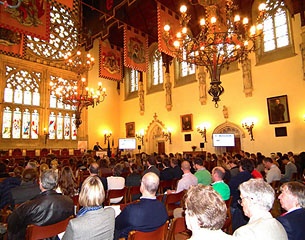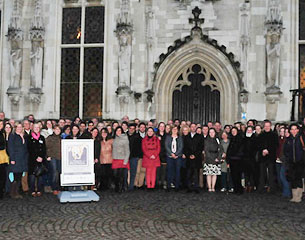
Over 220 delegates from 26 countries attended the 7th edition of the European Equine Health & Nutrition Congress (EEHNC) that was hosted in Brughes (Belgium) and focused on “Feeding the equine athlete”.
Internationally recognized specialists in nutrition, veterinary scientists, veterinarians, industry representatives and equine professionals attended this meeting.
The first day of this congress was dedicated to “Growing towards performance”. The following day was dedicated to “Feeding the Equine Athlete” (Friday). Participants could also follow practical workshops.
In a presentation on 'new thoughts on how to raise the potential equine athlete' from a nutrition perspective Prof Pat Harris (Waltham-on-the-Wolds, UK) explained how 'feeding the foal' commences with correct nutrition of the broodmare. Nutritional factors can 'program' aspects of foal development both pre and post parturition and this is a new exciting research area within the study into environmental factors leading to activation or dormancy of certain genes (Epigenetics – subgroup Nutrigenomics). In practice this may mean that overfeeding your mare and/or foal for fast growth may predispose it to develop obesity or insulin resistance later in life. This has to be confirmed in further studies. Similarly nutrition related 'stress' or underfeeding (e.g. weaning, fasting periods, lack of forage/grazing) may predispose the horse to behavioural problems later in life. Recent findings also point towards interactions of amino acids and importance of more than just lysine in the young horse and researchers are starting to get a better picture of the ideal protein profile in relation to musculoskeletal development. In relation to digestive gut health, we now have a better understanding of the microbial populations in the gut of foals which shows that they have developed an ability to utilise fibrous feed well at the age of 3 weeks already. The importance of maintaining a healthy 'microbiome' in the hindgut was also highlighted by Prof Harris in relation to immune and inflammatory mechanisms, once again through a possible epigenetics action. We need to use this new knowledge to ensure support for early training but also longevity in performance whilst maintaining good health and welfare.
Jan Boone (Ghent University) then told us about the advanced integration of much of this knowledge into training programmes for human athletes, such as basketball players and rowers. Fittening programmes are based on the principles of overloading, which leads to musculoskeletal tissue strengthening response (e.g. cartilage, tendons, and muscle), periods of rest and in particular individualisation towards the athlete and the specific demands required by their sport (high burst energy, endurance, combined training etc.). In human sports science measuring performance capacity to individualise training programmes for optimum performance are highly advanced and the horse sport is beginning to learn a lot from this. Ellen de Graaf-Roelsema (Utrecht University, NL), Céline Robert (École Nationale Véterinaire d'Alford, F) and Harold Brommer (Utrecht University, NL) showed that in top equine athletes these principles of overload, specificity, recovery and adaptation are beginning to be applied and that training specificity is now well developed with more professionalisation of training schedules. There is still the opportunity to integrate more science-based knowledge into training of equine athletes for increased performance and prevention of injuries. They gave a detailed insight into key aspects of Endurance, Eventing, Show Jumping and Dressage training.
One aspect of science application into equine athletic training is mitigating less desirable metabolic effects of high performance such as oxidative stress. Pierre Lekeux (University of Liege, BE) gave an excellent overview of how exercise can increase the imbalance between pro and anti-oxidants. This imbalance is mitigated by a good balanced diet and for horses in high levels of work complementary anti-oxidants need to be provided. Michael Lindinger (The Nutraceutical Alliance, CA) highlighted the latest state of research into the functioning of supplements claiming to have anti-oxidative or anti-inflammatory potential. Some evidence now exists but it is still ambiguous and more research needs to be done.
 On the second day of the congress the focus was on applied feeding of the equine athlete. The Team Veterinarian of the Belgian Equestrian Team, Jeroen Declercq, described the processes and importance of getting management right throughout training, travelling and competing. Prevention through good practice of shipping fever for horses travelling long distances was particularly discussed. Michael Lindinger and Wim Derave (Ghent University, BE) explored how to integrate nutrition into training programmes both in human and equine athletes focusing on differences and similarities in manipulating nutrient supply for top performance. Here the equine scientists and practitioners can still learn from some human experience and management methods. Certainly the ability to utilise fat by horses has opened new ways of supplying energy to equine athletes without the danger of overloading with soluble carbohydrates. This is especially well applied in Endurance horses.
On the second day of the congress the focus was on applied feeding of the equine athlete. The Team Veterinarian of the Belgian Equestrian Team, Jeroen Declercq, described the processes and importance of getting management right throughout training, travelling and competing. Prevention through good practice of shipping fever for horses travelling long distances was particularly discussed. Michael Lindinger and Wim Derave (Ghent University, BE) explored how to integrate nutrition into training programmes both in human and equine athletes focusing on differences and similarities in manipulating nutrient supply for top performance. Here the equine scientists and practitioners can still learn from some human experience and management methods. Certainly the ability to utilise fat by horses has opened new ways of supplying energy to equine athletes without the danger of overloading with soluble carbohydrates. This is especially well applied in Endurance horses.
Celine Roberts and Kristina Johansen contrasted and shared their experiences both as nutritional and veterinarian advisors and, in the case of Kristina, also as a competitor in high level endurance sport. The key take home message for the sport was not to change diet or introduce new feed close to or during a competition. For endurance horses, both agreed that we can cover energy requirements of athletes with good quality forage plus feed supplement and oil. High moisture containing feed and a suitable carrier for electrolytes (feed, water or paste) should be very familiar to the horses before competitions. Research has shown that owners who change the diet just before and during a competition have a reduced chance to finish a ride. Behaviourally, horses also need to be trained to accept and drink water during the long endurance rides, which requires some training.
Pat Harris then also gave an in-depth review of the latest research published in feeding dressage horses, show jumpers and eventers. The focus was on prevention of health issues (colics, ulcers and behavioural issues) while gaining optimum performance from the equine athlete. Rations need to provide energy and nutrients for growth (muscle), replenishment, repair and performance. Maintaining a healthy digestive tract by minimising periods of fasting (no more than 4 hours for prevention of ulcers, colics) and feeding adequate fibre for a good hindgut microbiome (at least 1.5% dry matter of body weight for prevention of colics, diarrhoea, laminitis) are vital. Recent research shows that young Standardbred horses (trotters) can be trained to race on a top quality forage diet with some mineral and vitamin supplementation only. The absolute need for ad libitum access to water was also highlighted and the latest advancements in Vitamin D research were discussed.
 The Director of Equine Sports Medicine of the British Equestrian Federation, John McEwen gave great insight into how the British Olympic equestrians are supported by top-level exercise physiologists, veterinarians and nutritionist throughout their training. Even rider fitness and nutrition is taken into account and this integrated multi-disciplinary approach was key in the recent great successes of the British equestrian teams. One aspect of travelling horses is that forage may need to be purchased in another country. When feed and forage cannot be brought (some Olympic venues for example) both are sent several months in advance back to the 'home' country so this is one acclimatisation the top sports horse does not have to make after a long journey.
The Director of Equine Sports Medicine of the British Equestrian Federation, John McEwen gave great insight into how the British Olympic equestrians are supported by top-level exercise physiologists, veterinarians and nutritionist throughout their training. Even rider fitness and nutrition is taken into account and this integrated multi-disciplinary approach was key in the recent great successes of the British equestrian teams. One aspect of travelling horses is that forage may need to be purchased in another country. When feed and forage cannot be brought (some Olympic venues for example) both are sent several months in advance back to the 'home' country so this is one acclimatisation the top sports horse does not have to make after a long journey.
In the final discussion international riders Anky van Grunsven, Karin Donckers and Lieven DeVos shared their feeding practices to provide insight in the feeding management of their horses during training, transport and international events.
The first EEHNC took place in Antwerp in 2000. The 7th EEHNC was organized in cooperation with the departments from the Faculty of Veterinary Medicine of Ghent University, Utrecht University and the University of Liège. The Animal Science Group (Wageningen University and Research Centre) was also involved.
-- EEHNC press release, by David van Doorn